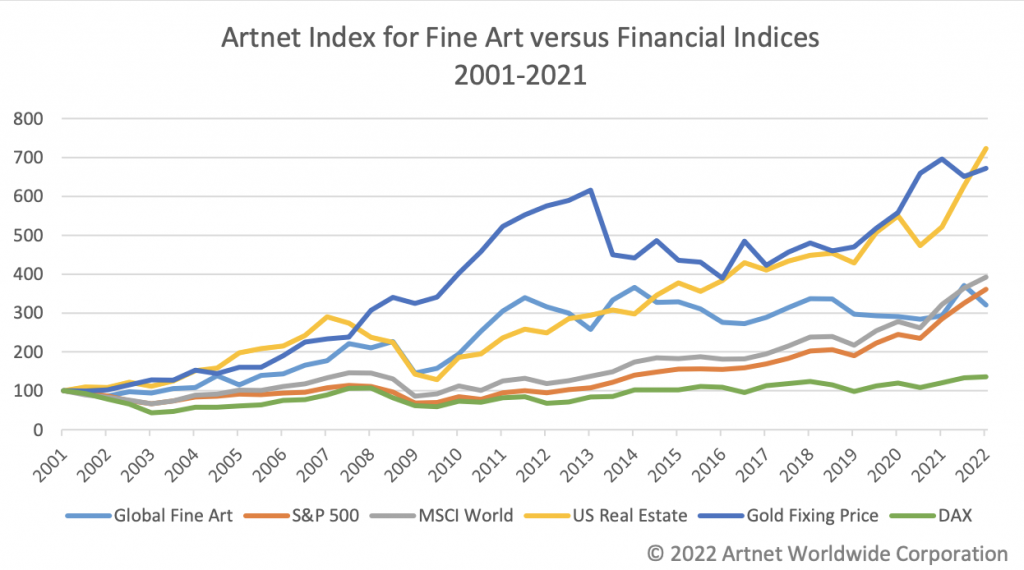Market
Five Takeaways on the Global Art-Market Outlook
Germany-based start-up arttrade dug into the Artnet Price Database to bring you five insights about how the auction market has evolved.

Germany-based start-up arttrade dug into the Artnet Price Database to bring you five insights about how the auction market has evolved.

Artnet News in Partnership With arttrade

The art market can seem difficult to grasp—but with the right data and analysis, it becomes much easier to comprehend. Germany-based start-up arttrade dug into the Artnet Price Database to bring you five insights about how the fine-art auction market has evolved—and what you as an art investor need to know to get the most out of this dynamic, fast-changing industry.
Total auction sales in 2021 reached $16.5 billion, making it the art market’s most lucrative year ever. The previous peak, in 2014, generated $16.3 billion in total sales. (Our figures do not account for inflation.) Last year marked a remarkable recovery from the pandemic-era trough, when the auction market slumped to $10.2 billion, a more-than-decade low. The startling 62 percent rebound can be attributed to a number of factors: the surging stock market, an influx of cash that the wealthy rushed to store in collectibles, anxiety about inflation, and an almost unprecedented level of high-quality collections hitting the market.
Even in 2020, the art market proved somewhat insulated from broader economic trends—total auction sales contracted just under 25 percent, considerably less than some experts feared given the pandemic’s toll on other sectors.
The top of the art market also rebounded more quickly than other asset classes, according to Artnet’s index of the top 100 best-performing artists. In 2021, the blue-chip art market outpaced the S&P 500 and the MSCI World Index. (Artnet’s indices track the evolution of artwork prices over time based on the performance of sales of paintings and works on paper by the 100 top-selling artists in a given category over the preceding three years.) Looking ahead, some suggest art may also benefit from rampant inflation, which is reaching 40-year highs in the U.S., as it can be seen as a secure store of value during times of financial volatility.

Courtesy of Artnet Analytics.
No segment of the auction market is growing faster than ultra-contemporary art, our term for work made by artists born in 1975 and later. Although it still remains a small slice of the overall market—less than five percent—it is expanding rapidly. The only genre that continued to grow during the pandemic, ultra-contemporary sales jumped another 190 percent between 2020 and 2021, to $739.4 million. Many attribute this expansion to the entry of a new class of younger collectors into the market, particularly in Asia, where the demand for new art has been especially strong. The top-selling artists in this genre blend figurative painting and new media. They are: Adrian Ghenie (b. 1977), Beeple (b. 1981), Jonas Wood (b. 1977), Matthew Wong (1984–2019), and Jia Aili (b. 1979).
This sector is also volatile. Consider that during the previous market peak, in 2013–4, the ultra-contemporary art market was dominated by the so-called “Zombie Formalists,” whose macho take on process-based abstraction fetched prices as much as 3,000 times their estimates—only to crash two years later.
Contemporary art, which we define as work made by artists born between 1944 and 1975, also had its best year ever in 2021, bringing in a total of $2 billion at auction. That’s up 109 percent from 2020 and 40 percent from pre-pandemic 2019. Notably, the spike was driven less by an increase in the value of works on offer (the average price of a contemporary artwork rose by only $333 from 2019, to $41,337) than by an increase in sales volume. The number of contemporary lots sold spiked almost 40 percent between 2019 and 2021, to 48,736. This is likely driven both by an increase in supply from sellers, and auction houses’ growing ability to offload material through a combination of online strategies they developed during the pandemic and live sales restored after lockdown.

Auctioneer Oliver Barker holding court over Sotheby’s global e-auctions. Courtesy of Sotheby’s.
Auction houses, which had been relatively slow to adapt to the Internet revolution, pivoted rapidly to the web during 2020. While IRL sales were limited or impossible, online transactions spiked. Sotheby’s, Christie’s, and Phillips sold a combined $1 billion in art online in 2020, up 1,007 percent from 2019. Miraculously, a year spent in lockdown seems to have permanently altered buyer (and seller) behavior, meaning that total online sales continued to grow even after the world began to emerge from lockdown. In 2021, the total value of art sold online from Sotheby’s, Christie’s, and Phillips climbed another 36 percent, to $1.4 billion. The industry as a whole has become more efficient, NFTs have taken the art world by storm, and entirely new business models—like arttrade, which seeks to enable people to easily and indirectly invest in art—have evolved in this environment.
While it is too soon to say how the current stock-market volatility will affect the broader art and financial markets, it is clear that fine art is among the more volatile alternative investments—but also one of the most potentially lucrative, and can serve as an asset in a diversified portfolio.
Fine art saw a volatility score of 20 percent, on par with the DAX (Germany’s blue-chip stock index), but higher than the S&P 500 (15 percent) and gold (15 percent), among others. In the short-term, work by ultra-contemporary artists delivers the highest return: the emerging art index saw a 36 percent 12 month annual return, outpaced only by U.S. real estate’s 39 percent return. (Blue-chip art across all time periods and contemporary art both saw a nine percent 12 month annual return.)
Over a longer period, ultra-contemporary’s growth slowed. All three categories we examined—blue-chip art, contemporary art, and ultra-contemporary art—settled into a roughly 4 percent compound annual growth rate over 15 years. Individual artists, however, can outperform the average considerably.
In short, those with experience and good information may be able to benefit from the booming art market in the short term, but as a long-term play, it’s a riskier proposition. Nevertheless, if you choose carefully and have the right timing, art can deliver a meaningful return.